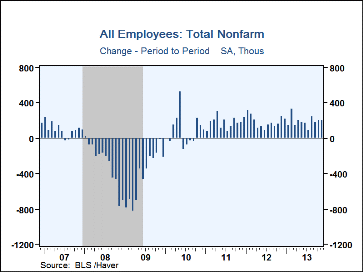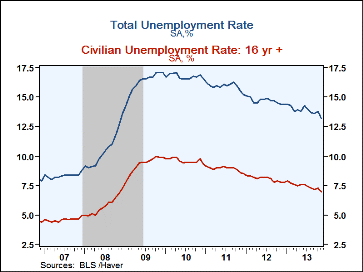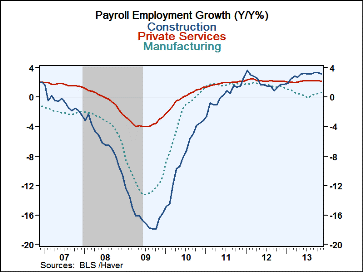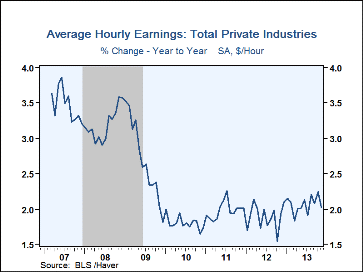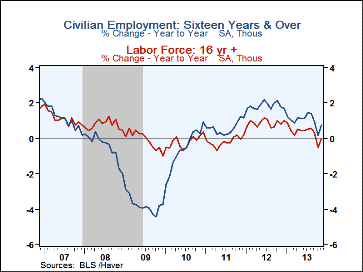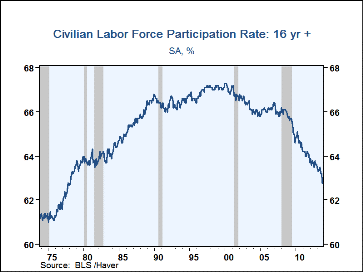 Global| Dec 06 2013
Global| Dec 06 2013U.S. Payroll Employment Gain is Steady; Unemployment Rate Falls To Lowest Level Since 2008
by:Tom Moeller
|in:Economy in Brief
Summary
Job market improvement remains on a steady, if moderate, growth track. Nonfarm payroll employment grew 203,000 (1.7% y/y) during November following slightly revised gains of 200,000 and 175,000 during the prior two months. The rise [...]
Job market improvement remains on a steady, if moderate, growth track. Nonfarm payroll employment grew 203,000 (1.7% y/y) during November following slightly revised gains of 200,000 and 175,000 during the prior two months. The rise beat consensus expectations for 180,000 growth. The unemployment rate fell to 7.0%, the lowest since November 2008. Expectations were for 7.2%. The total jobless rate, including workers who are marginally attached and part-time for economic reasons, dropped to 13.2%, also the lowest since November 2008.
From the payroll employment survey, the 203,000 increase in jobs left the three-month average gain at 193,000. That's off its peak of 271,000 early last year. Factory sector job growth of 27,000 last month also left the 17,000 three-month average at just half its 2012 high. The 17,000 rise in construction employment similarly generated a 15,000 three-month average which was below the high of 37,000 early this year. Private service sector job growth moderated to 152,000 from a three-month average of 196,000 this past April. A 60,000 worker rise (1.9% y/y) in trade, transportation & utilities led last month's gain in payrolls. That was followed by educational & health services where jobs rose 40,000 (1.8% y/y) and a 35,000 gain (3.5% y/y) in professional & business services. Of the latter, temporary help services employment increased a strong 16,400 (8.6% y/y). Retail trade jobs rose 22,300 (2.2% y/y), although that was down sharply from the 35,800 average of the prior three months. Also slower was the 17,000 (3.0% y/y) increase in leisure & hospitality employment which was roughly half the gains of the prior three months. Employment in financial activities slipped 3,000 (+1.1% y/y) and information services jobs fell 1,000 (0.0% y/y).
Despite these moderations, 61.5% of nonfarm industries added to payrolls last month, the most since February. In the factory sector, 56.2% of industries added to payrolls, also the greatest since February.
The length of the average workweek increased to 34.5 hours but that remained below the 34.6 high in March. The factory sector workweek of 41.0 hours was a new high. The construction workweek of 39.1 hours also neared its high but the private services workweek of 33.3 hours was below its March 2008 peak of 33.5 hours. So far this quarter, the index of aggregate hours worked (employment times hours) is up 1.8% (AR) from 3Q following that quarter's 1.0% rise.
Average hourly earnings gained 0.2% (2.0% y/y) last month. Earnings in the factory sector rose 0.3% (2.4% y/y) but private service sector earnings ticked up just 0.1% (2.0% y/y).
From the household jobs survey, the sharp drop in the unemployment rate to 7.0% reflected an 818,000 worker rise (0.8% y/y) in employment and a 455,000 gain (0.0% y/y) in the labor force. The average length of unemployment ticked up to 37.2 weeks last month; down from the 40.7 average in late-2011 but still higher than the 2001 average of 13.1 weeks.
The population of 246,567 million was up 1.0% y/y. The number of potential workers not in the labor force was near its high at 91,273 million (2.7% y/y). The labor force participation rate of a still-low 63.0% was down from 67.1% in each year from 1997 to 2000. The labor force participation rate for individuals with less than a high school diploma was 44.6% while for high school graduates with no college it was 58.3%. For those with some college or an associate degree the average was 67.7% while for individuals with a bachelors degree or higher it was 75.2%.
The figures referenced above are available in Haver's USECON database. Additional detail can be found in the LABOR and in the EMPL databases. The expectation figures are from Action Economics and are in the AS1REPNA database.
| Employment: (M/M Chg., 000s) | Nov | Oct | Sep | Y/Y | 2012 | 2011 | 2010 |
|---|---|---|---|---|---|---|---|
| Payroll Employment | 203 | 200 | 175 | 1.7% | 1.7% | 1.2% | -0.7% |
| Previous | -- | 204 | 163 | -- | 1.4 | 1.2 | -0.7 |
| Manufacturing | 27 | 16 | 8 | 0.6 | 1.7 | 1.7 | -2.7 |
| Construction | 17 | 12 | 17 | 3.1 | 2.0 | 0.3 | -8.3 |
| Private Service Producing | 152 | 183 | 139 | 2.2 | 2.2 | 1.9 | -0.1 |
| Government | 7 | -14 | 7 | -0.1 | -0.8 | -1.8 | -0.3 |
| Average Weekly Hours - Private Sector | 34.5 | 34.4 | 34.4 | 34. (Nov'12) |
34.4 | 34.4 | 34.1 |
| Average Private Sector Hourly Earnings (%) | 0.2 | 0.1 | 0.2 | 2.0 | 1.9 | 2.0 | 1.8 |
| Unemployment Rate (%) | 7.0 | 7.3 | 7.2 | 7.8 (Nov'12) |
8.1 | 8.9 | 9.6 |
Tom Moeller
AuthorMore in Author Profile »Prior to joining Haver Analytics in 2000, Mr. Moeller worked as the Economist at Chancellor Capital Management from 1985 to 1999. There, he developed comprehensive economic forecasts and interpreted economic data for equity and fixed income portfolio managers. Also at Chancellor, Mr. Moeller worked as an equity analyst and was responsible for researching and rating companies in the economically sensitive automobile and housing industries for investment in Chancellor’s equity portfolio. Prior to joining Chancellor, Mr. Moeller was an Economist at Citibank from 1979 to 1984. He also analyzed pricing behavior in the metals industry for the Council on Wage and Price Stability in Washington, D.C. In 1999, Mr. Moeller received the award for most accurate forecast from the Forecasters' Club of New York. From 1990 to 1992 he was President of the New York Association for Business Economists. Mr. Moeller earned an M.B.A. in Finance from Fordham University, where he graduated in 1987. He holds a Bachelor of Arts in Economics from George Washington University.


